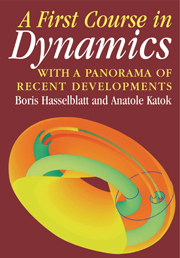Book contents
- Frontmatter
- Contents
- Preface
- 1 Introduction
- PART 1 A COURSE IN DYNAMICS: FROM SIMPLE TO COMPLICATED BEHAVIOR
- 2 Systems with Stable Asymptotic Behavior
- 3 Linear Maps and Linear Differential Equations
- 4 Recurrence and Equidistribution on the Circle
- 5 Recurrence and Equidistribution in Higher Dimension
- 6 Conservative Systems
- 7 Simple Systems with Complicated Orbit Structure
- 8 Entropy and Chaos
- PART 2 PANORAMA OF DYNAMICAL SYSTEMS
- Reading
- APPENDIX
- Hints and Answers
- Solutions
- Index
6 - Conservative Systems
Published online by Cambridge University Press: 05 June 2012
- Frontmatter
- Contents
- Preface
- 1 Introduction
- PART 1 A COURSE IN DYNAMICS: FROM SIMPLE TO COMPLICATED BEHAVIOR
- 2 Systems with Stable Asymptotic Behavior
- 3 Linear Maps and Linear Differential Equations
- 4 Recurrence and Equidistribution on the Circle
- 5 Recurrence and Equidistribution in Higher Dimension
- 6 Conservative Systems
- 7 Simple Systems with Complicated Orbit Structure
- 8 Entropy and Chaos
- PART 2 PANORAMA OF DYNAMICAL SYSTEMS
- Reading
- APPENDIX
- Hints and Answers
- Solutions
- Index
Summary
PRESERVATION OF PHASE VOLUME AND RECURRENCE
We will see that preservation of phase volume is a natural property that holds, for example, in dynamical systems arising from mechanics, and that this property is a direct cause for ubiquitous nontrivial recurrence.
Criteria for Preservation of Volume
So far we have been concerned with the asymptotic behavior of individual orbits of a dynamical system. The basic examples discussed in Chapter 4 and Chapter 5 exhibit recurrent behavior of orbits: All orbits are either periodic, that is, return exactly to the initial position, or come arbitrarily close to the initial position, as in an irrational rotation of the circle, a nonperiodic translation of the torus, or in free particle motion on the torus. This type of behavior is different from most of the phenomena observed in Chapter 2 and Chapter 3. There, typically a nonperiodic orbit was attracted to periodic ones, and recurrence appeared only for periodic orbits, which in all nonlinear and most linear examples were few in number.
A key to understanding this difference is given by a property that is not directly observed by looking at individual orbits but by considering the evolution of large sets of initial conditions simultaneously, the preservation of phase volume.
Preservation of Phase Volume. This property is simply that the map defining a discrete-time dynamical system (or, in the case of flows, each time-t map) preserves the volume of sets in the phase space.
Information
- Type
- Chapter
- Information
- A First Course in Dynamicswith a Panorama of Recent Developments, pp. 155 - 195Publisher: Cambridge University PressPrint publication year: 2003
